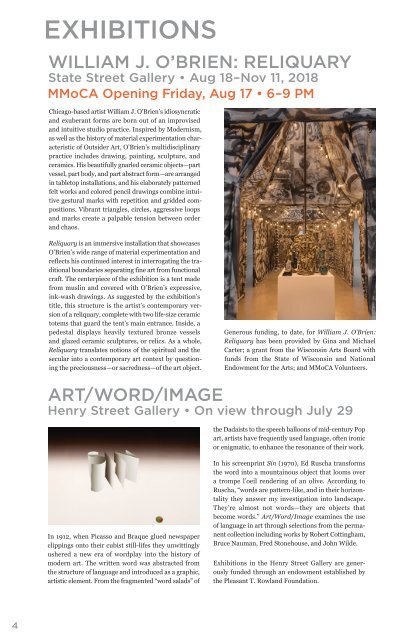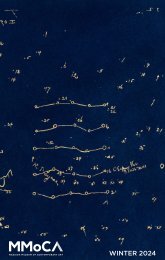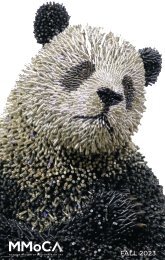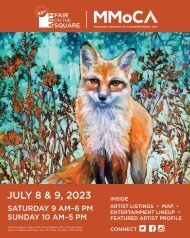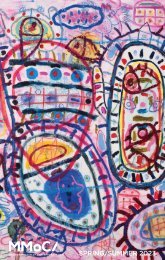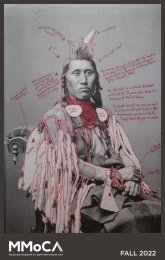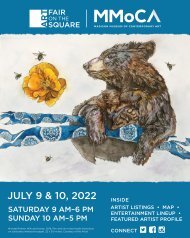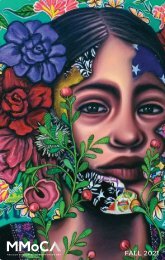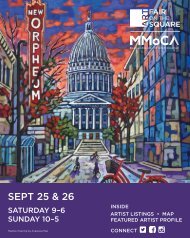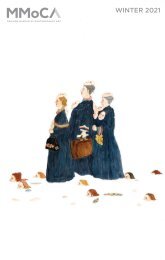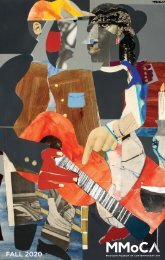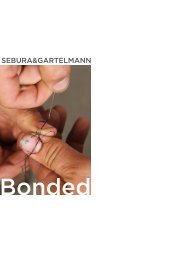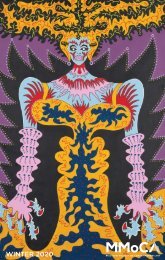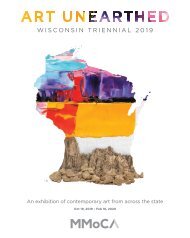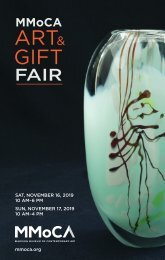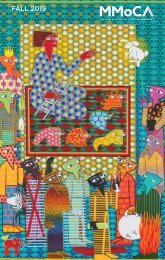Summer 2018 MMoCA newsletter
Newsletter of the Madison Museum of Contemporary Art, with articles about exhibitions (Far Out: Art from the 1960s, Art/Word/Image, Irene Grau: construction season, and The House of Sparkling Glasses: A Celluloid Experience by M.J. Paggie), events, education, and supporting the arts.
Newsletter of the Madison Museum of Contemporary Art, with articles about exhibitions (Far Out: Art from the 1960s, Art/Word/Image, Irene Grau: construction season, and The House of Sparkling Glasses: A Celluloid Experience by M.J. Paggie), events, education, and supporting the arts.
Create successful ePaper yourself
Turn your PDF publications into a flip-book with our unique Google optimized e-Paper software.
EXHIBITIONS<br />
WILLIAM J. O’BRIEN: RELIQUARY<br />
State Street Gallery • Aug 18–Nov 11, <strong>2018</strong><br />
<strong>MMoCA</strong> Opening Friday, Aug 17 • 6–9 PM<br />
Chicago-based artist William J. O’Brien’s idiosyncratic<br />
and exuberant forms are born out of an improvised<br />
and intuitive studio practice. Inspired by Modernism,<br />
as well as the history of material experimentation characteristic<br />
of Outsider Art, O’Brien’s multidisciplinary<br />
practice includes drawing, painting, sculpture, and<br />
ceramics. His beautifully gnarled ceramic objects—part<br />
vessel, part body, and part abstract form—are arranged<br />
in tabletop installations, and his elaborately patterned<br />
felt works and colored pencil drawings combine intuitive<br />
gestural marks with repetition and gridded compositions.<br />
Vibrant triangles, circles, aggressive loops<br />
and marks create a palpable tension between order<br />
and chaos.<br />
Reliquary is an immersive installation that showcases<br />
O’Brien’s wide range of material experimentation and<br />
reflects his continued interest in interrogating the traditional<br />
boundaries separating fine art from functional<br />
craft. The centerpiece of the exhibition is a tent made<br />
from muslin and covered with O’Brien’s expressive,<br />
ink-wash drawings. As suggested by the exhibition’s<br />
title, this structure is the artist’s contemporary version<br />
of a reliquary, complete with two life-size ceramic<br />
totems that guard the tent’s main entrance. Inside, a<br />
pedestal displays heavily textured bronze vessels<br />
and glazed ceramic sculptures, or relics. As a whole,<br />
Reliquary translates notions of the spiritual and the<br />
secular into a contemporary art context by questioning<br />
the preciousness—or sacredness—of the art object.<br />
Generous funding, to date, for William J. O’Brien:<br />
Reliquary has been provided by Gina and Michael<br />
Carter; a grant from the Wisconsin Arts Board with<br />
funds from the State of Wisconsin and National<br />
Endowment for the Arts; and <strong>MMoCA</strong> Volunteers.<br />
ART/WORD/IMAGE<br />
Henry Street Gallery • On view through July 29<br />
the Dadaists to the speech balloons of mid-century Pop<br />
art, artists have frequently used language, often ironic<br />
or enigmatic, to enhance the resonance of their work.<br />
In 1912, when Picasso and Braque glued newspaper<br />
clippings onto their cubist still-lifes they unwittingly<br />
ushered a new era of wordplay into the history of<br />
modern art. The written word was abstracted from<br />
the structure of language and introduced as a graphic,<br />
artistic element. From the fragmented “word salads” of<br />
In his screenprint Sin (1970), Ed Ruscha transforms<br />
the word into a mountainous object that looms over<br />
a trompe l’oeil rendering of an olive. According to<br />
Ruscha, “words are pattern-like, and in their horizontality<br />
they answer my investigation into landscape.<br />
They’re almost not words—they are objects that<br />
become words.” Art/Word/Image examines the use<br />
of language in art through selections from the permanent<br />
collection including works by Robert Cottingham,<br />
Bruce Nauman, Fred Stonehouse, and John Wilde.<br />
Exhibitions in the Henry Street Gallery are generously<br />
funded through an endowment established by<br />
the Pleasant T. Rowland Foundation.<br />
4


